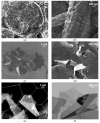Workers' Exposure Assessment during the Production of Graphene Nanoplatelets in R&D Laboratory
- PMID: 32756523
- PMCID: PMC7466624
- DOI: 10.3390/nano10081520
Workers' Exposure Assessment during the Production of Graphene Nanoplatelets in R&D Laboratory
Abstract
Widespread production and use of engineered nanomaterials in industrial and research settings raise concerns about their health impact in the workplace. In the last years, graphene-based nanomaterials have gained particular interest in many application fields. Among them, graphene nanoplatelets (GNPs) showed superior electrical, optical and thermal properties, low-cost and availability. Few and conflicting results have been reported about toxicity and potential effects on workers' health, during the production and handling of these nanostructures. Due to this lack of knowledge, systematic approaches are needed to assess risks and quantify workers' exposure to GNPs. This work applies a multi-metric approach to assess workers' exposure during the production of GNPs, based on the Organization for Economic Cooperation and Development (OECD) methodology by integrating real-time measurements and personal sampling. In particular, we analyzed the particle number concentration, the average diameter and the lung deposited surface area of airborne nanoparticles during the production process conducted by thermal exfoliation in two different ways, compared to the background. These results have been integrated by electron microscopic and spectroscopic analysis on the filters sampled by personal impactors. The study identifies the process phases potentially at risk for workers and reports quantitative information about the parameters that may influence the exposure in order to propose recommendations for a safer design of GNPs production process.
Keywords: 2D nanostructures; exposure assessment; graphene nanoplatelets; nanotechnologies; occupational safety and health; risk mitigation.
Conflict of interest statement
The authors declare no conflict of interest.
Figures














References
-
- Jacobsen N., Pogana G., White P., Moller P., Cohn C.A., Korsholm K.S., Vogel U., Marcomini A., Loft S., Wallin H. Genotoxicity, cytotoxicity, and reactive oxygen species induced by single-walled carbon nanotubes and C60 fullerenes in the FE1-MutaTMMouse lung epithelial cells. Environ. Mol. Mutagen. 2008;49:476–487. doi: 10.1002/em.20406. - DOI - PubMed
LinkOut - more resources
Full Text Sources

